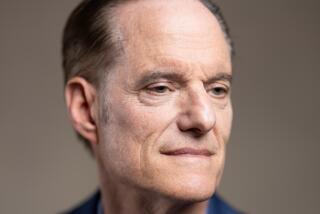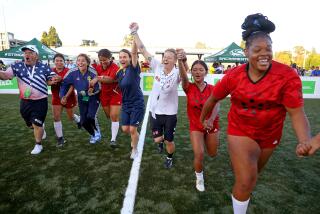The Word Is Out on Independent Living Center : Disabled: The first lady of Czechoslovakia is the latest foreign guest to visit. She heads a foundation in her own country that does similar work.
- Share via
The word about the Westside Center for Independent Living appears to have gone international. Recently, Olga Havel, the first lady of Czechoslovakia, visited the center to look at what it does to help people with disabilities.
Havel heads a foundation in Czechoslovakia that does similar work.
For the record:
12:00 a.m. Nov. 17, 1991 For the Record
Los Angeles Times Sunday November 17, 1991 Home Edition Westside Part J Page 4 Column 1 Zones Desk 1 inches; 21 words Type of Material: Correction
Photo credit--A photograph that ran with a story about the Westside Center for Independent Living on Thursday should have been credited to Julie Brown.
“In Czechoslovakia we’d prefer to let people lead a normal life and also to be employed in meaningful work,” Havel said through her interpreter while touring the facility’s Computer Training Center.
Havel was directed to the center by Douglas Martin, assistant to the chancellor and disabled affairs compliance officer at UCLA. He also has served as the independent living center’s executive director.
Martin was aware of the work done by the Czech foundation that bears Havel’s name and thought she might be interested in seeing how the center in West Los Angeles operates. Havel’s husband, Vaclav Havel, was visiting UCLA for a speaking engagement.
The center receives phone calls asking for information from all over the world, and foreign visitors have arrived at its doorstep three to four times in the last 1 1/2 years to see the work done there. But although the center staff is pleased with the recognition, they see their work as their first priority.
Stan Greenberg, the center’s executive director who has been blind since birth, said, “Our goal is to have people with disabilities completely integrated into society.”
That’s a tall order. Only 8% of the center’s clients are employed, said Lynne McKinney, independent living services manager. That is not surprising given that two-thirds of all disabled Americans between the ages of 16 and 64 are unemployed; that amounts to 12.4 million people. Of these, 8.2 million want to work, McKinney said.
Disability should not automatically relegate a person to the unemployment line, said McKinney, adding that at the center, 70% of the staff “are people with disabilities, partly so we can serve as role models.” McKinney uses a wheelchair.
The services provided at the center include an attendant registry, housing and consumer and community advocacy counseling.
Jim Andrews credits the center with helping him to adjust to his life after spinal cancer. After being operated on in 1988, the 38-year-old, whose life had revolved around volleyball and the beach, found himself in a wheelchair. For a long time he sat home alone trying to deal with what had happened.
Eventually, he hooked up with the center.
“Through (the center) I got to the point where I thought enough of myself to know that it wasn’t a hopeless existence. Through them I found my own life,” Andrews said.
He now works in information and referral for the center, providing others with information about services, products and community resources.
The center is involved in educating the public as well as its clients. Although Greenberg is without sight, please don’t call him disabled. “Language is very important to us,” said Greenberg. “We don’t speak about people as the disabled, but people with disabilities, emphasizing that we are people first. Disability is just one more of the things that is known about us.”
More to Read
Sign up for Essential California
The most important California stories and recommendations in your inbox every morning.
You may occasionally receive promotional content from the Los Angeles Times.













